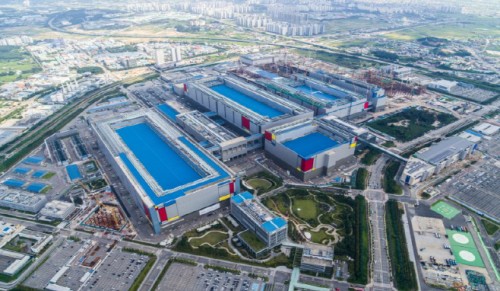 |
| The photo shows Samsung Electronics’ chip plant in Pyeongtaek, south of Seoul./ Source: Samsung Electronics |
By AsiaToday reporters Jung Moon-kyung & Choi Ji-hyun
Samsung Electronics Co. said Wednesday its DRAM memory chip business turned to the black in the fourth quarter of last year. With its DRAM chip recovery, the company narrowed its chip deficit by more than 40 percent, and expects that it could make a surplus in memory chips including NAND during the first quarter.
In its fourth quarter earnings announcement, Samsung said it achieved an operating profit of 2.82 trillion won ($2.11 billion), down 34.4 percent from the same period of 2022. On an annual basis, Samsung posted an operating profit of 6.57 trillion won, down 84.9 percent year-on-year.
What should be noted is the improved chip performance. The company posted sales of 21.69 trillion won in the fourth quarter, up 5.25 trillion won from the previous quarter, and its deficit shrank 1.57 trillion won to 2.18 trillion won over the same period. This is due to increasing sales of premium products, including high bandwidth memory (HBM) chips and double data rate 5 (DDR) products in the wake of the advent of the generative AI era. Increased memory capacity of personal computers and mobile devices also had a positive impact on the performance. Samsung said it expects its memory chip business will record a profit in the first quarter.
Samsung’s foundry business posted a record number of orders focused on high-performance computing (HPC) over the three months. Its display sales came to 9.66 trillion won in the fourth quarter, which is 1.44 trillion won more than the previous quarter. However, as demand for smartphones declined ahead of the launch of the Galaxy S24 series, operating profit of its DX (Device eXperience) sector fell by 1.6 trillion won from the previous quarter to 2.62 trillion won.
Although Samsung’s profit plunged in the fourth quarter, it invested 7.55 trillion won into research and development, marking the largest quarterly investment by the company. Its facility investment came to 16.4 trillion won. On an annual basis, its investment came to 53.1 trillion won, the same level as the previous year. Samsung Electronics will maintain its shareholder return policy and pay 9.8 trillion won in dividends over the next three years. It plans to return 50 percent of its surplus cash flow to shareholders over the next three years until 2026.
#Samsung #DRAM #4Q #profit #memory chip
Copyright by Asiatoday
Most Read
-
1
-
2
-
3
-
4
-
5
-
6
-
7





















